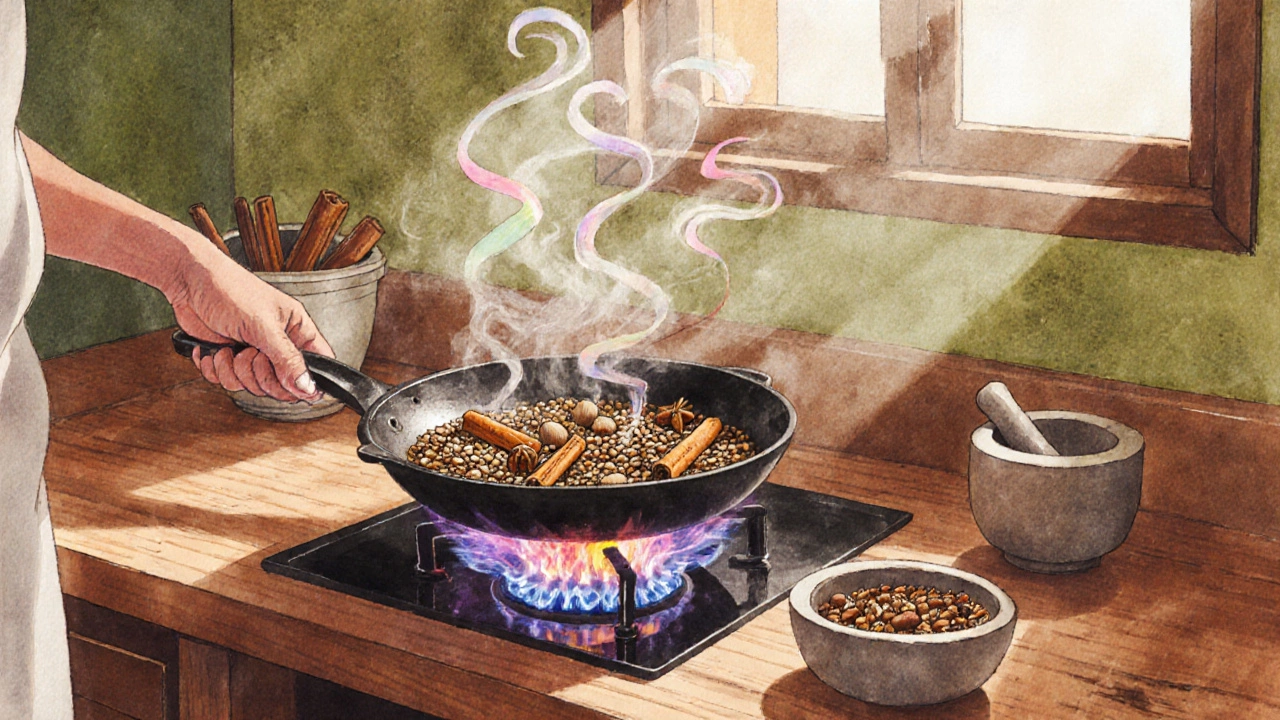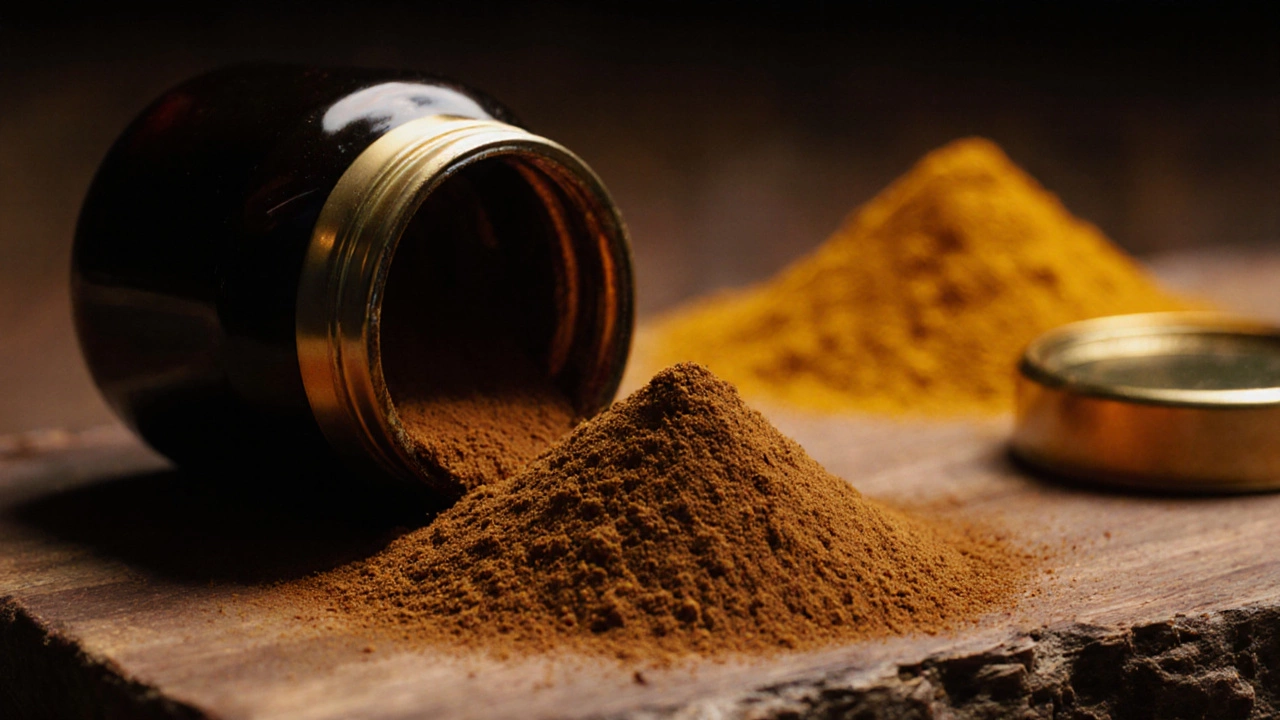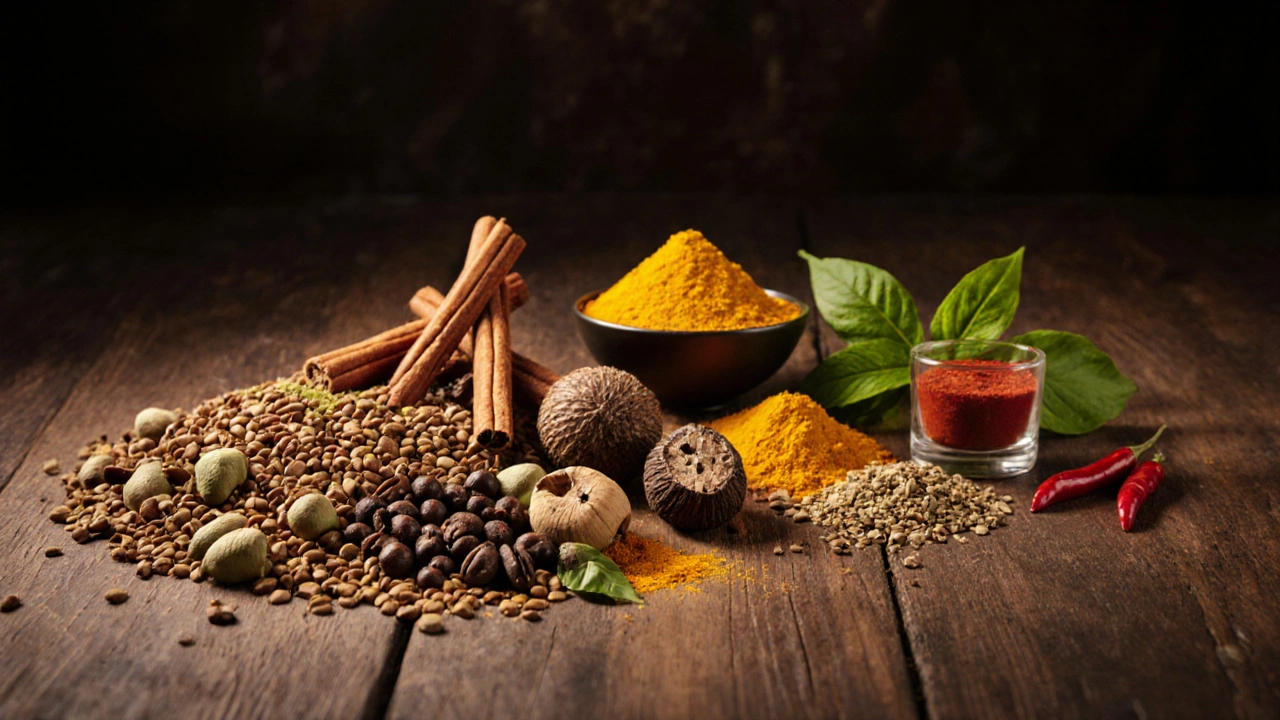Garam Masala Spice Checker
Common Garam Masala Spices
Cumin
Earthy, nutty, backbone of many blends
Coriander
Citrusy and slightly sweet
Cardamom
Fragrant, almost floral
Clove
Intensely aromatic, a pinch is enough
Cinnamon
Sweet-spicy, gives that warm hug
Black Pepper
The real "heat"; sharp and pungent
Nutmeg
Subtle, nutty, rounds out the blend
Bay Leaf
Adds herbal, slightly floral note
Mace
Outer covering of nutmeg, extra aroma
Spices NOT Used in Garam Masala
Turmeric
Bright yellow, earthy, used for color
Mustard Seed
Sharp, pungent, typical in tempering
Curry Leaves
Fresh, citrusy, added during tempering
Red Chili Powder
Adds heat, garam masala uses black pepper
Fenugreek Leaves
Herbaceous, used at end of cooking
Comparison Table
| Included in Classic Garam Masala | Not Used in Garam Masala |
|---|---|
| Cumin | Turmeric |
| Coriander | Mustard Seed |
| Cardamom | Curry Leaves |
| Clove | Red Chili Powder |
| Cinnamon | Fenugreek Leaves |
| Black Pepper | |
| Nutmeg (or Mace) |
Quick Takeaways
- Traditional garam masala never contains turmeric, mustard seed, curry leaves or red chili powder.
- Core ingredients are cumin, coriander, cardamom, clove, cinnamon, black pepper and nutmeg (plus occasional bay leaf or mace).
- Spices that are left out are usually bright‑yellow or hot, which would clash with the warm, sweet‑spicy balance garam masala aims for.
- If a recipe calls for those “extra” spices, it’s a regional twist, not the classic blend.
- Knowing what’s omitted helps you tweak the blend for your taste without ruining the flavor profile.
What Is Garam Masala?
Garam Masala is a traditional North Indian spice blend meant to add warmth and depth to dishes. The name translates to “hot spice mixture”, but “hot” refers to aromatic intensity rather than heat. Most households keep a small jar of garam masala on the shelf and sprinkle it at the end of cooking to finish a curry, soup, or stew.
Core Spices Typically Found in Garam Masala
While families create their own versions, nine spices appear in the majority of authentic blends. Below are the staples, each marked up for easy identification.
- Cumin - earthy, nutty, the backbone of many Indian mixes.
- Corriander - citrusy and slightly sweet, balances the deeper notes.
- Cardamom - fragrant, almost floral, adds a bright lift.
- Clove - intensely aromatic, a pinch is enough to make an impact.
- Cinnamon - sweet‑spicy, gives that signature warm hug.
- Black Pepper - the real “heat” in garam masala; sharp and pungent.
- Nutmeg - subtle, nutty, rounds out the blend.
- Bay Leaf - adds a herbal, slightly floral note (optional).
- Mace - the outer covering of nutmeg, sometimes used for extra aroma.

Spices People Often Mistake for Garam Masala Ingredients
Many cooks assume that any Indian spice can go into garam masala. That’s not true. Below are the most common intruders.
- Turmeric - bright yellow, earthy, used for color and mild bitterness; rarely in garam masala.
- Mustard Seed - sharp, pungent, typical in pickles and tempering, not in the blend.
- Curry Leaves - fresh, citrusy, usually added during tempering, never ground into the mix.
- Red Chili Powder - adds heat, but garam masala relies on black pepper for its spice level.
- Fenugreek Leaves (Kasuri Methi) - herbaceous, used at the end of cooking, not ground into the base blend.
These spices are great in Indian cooking, just not in a classic garam masala. When you see them listed, it’s either a regional adaptation (e.g., Kashmiri garam masala adds fennel) or a recipe‑specific twist.
Why Those Spices Are Left Out
The purpose of garam masala is to impart a warm, sweet‑spicy aroma that lingers after cooking. Each core spice contributes to that specific flavor profile. The “intruders” either clash visually (turmeric’s yellow overwhelms the brown‑gold hue) or introduce competing heat (red chili) or fresh herbaceous notes (curry leaves) that dilute the intended balance.
How to Spot a Genuine Garam Masala Blend
If you pick up a pre‑made jar, read the label. Authentic blends will list the core spices and avoid the bright‑colored ones. Many brands also note “no added turmeric” as a selling point. When in doubt, trust the smell-if you get a deep, sweet, slightly peppery aroma, you’re probably looking at the right mix.

Customizing Your Own Blend Without the “Wrong” Spices
- Toast whole spices (cumin seeds, coriander seeds, cardamom pods, clove, cinnamon sticks, black peppercorns, nutmeg) lightly in a dry pan.
- Cool them completely, then grind in a spice grinder or mortar‑pestle.
- Sift the powder to remove any larger fragments.
- Store in an airtight jar away from light; the blend stays fresh for about 6 months.
Feel free to experiment by adding a pinch of fennel or star anise if you enjoy a sweeter edge, but keep out turmeric, mustard seed, and red chili powder to preserve the classic profile.
Quick Reference Table
| Included | Typically Excluded |
|---|---|
| Cumin | Turmeric |
| Corriander | Mustard Seed |
| Cardamom | Curry Leaves |
| Clove | Red Chili Powder |
| Cinnamon | Fenugreek Leaves |
| Black Pepper | |
| Nutmeg (or Mace) |
Pro Tips for Using Garam Masala
- Add it at the end of cooking (last 5 minutes) to keep the aromatics fresh.
- A teaspoon for a pot of curry (about 4‑6 servings) is a good rule of thumb.
- If you accidentally use a blend with turmeric, cut the amount in half and balance with a touch more black pepper.
- Store the blend in a dark glass jar; light speeds up flavor loss.
- For a milder version, skip the clove and reduce the black pepper.
Frequently Asked Questions
Can I add turmeric to garam masala?
Traditional garam masala does not include turmeric. Adding it will change the color and introduce a mild bitterness that isn’t part of the classic flavor profile.
Why do some recipes list mustard seed in garam masala?
Those recipes are using regional variations, especially from South India, where mustard seed may appear in a local “masala” mix. It’s not the standard North Indian garam masala.
How long does homemade garam masala stay fresh?
Stored in an airtight container away from light, it keeps its peak aroma for about 6months. After that, the flavors will fade but it’s still safe to use.
Is garam masala the same as curry powder?
No. Curry powder is a Western invention that usually contains turmeric, coriander, cumin, and often mustard seed. Garam masala focuses on warm, sweet, and peppery notes without the bright yellow turmeric.
What’s the best way to toast whole spices for garam masala?
Use a dry skillet over medium heat. Stir constantly until the spices turn fragrant and slightly darker, usually 2‑3minutes. Let them cool before grinding.
If you’re still unsure which blend to pick up at the store, remember this: a true garam masala will never list turmeric, mustard seed, or red chili powder among its ingredients. Those are the spices not used in garam masala, and keeping them out preserves the blend’s signature warmth.
